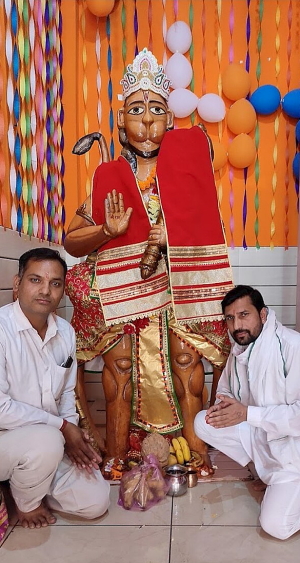
Celebrating Hanuman Jayanti in Uttar Pradesh, India. Photo by Mahant Brijbhushan Das, courtesy of Wikimedia Commons
TUESDAY, APRIL 23: In many regions of India, today marks is the annual celebration of the birth of deity that is one-half human, and one-half monkey: It is Hanuman Jayanti.
Ever a steadfast and ardent devotee of Lord Rama, Hanuman often is honored along with Lord Rama; devotees of Hanuman hope to obtain his strength and energy. The Ramayana and other texts detail his crediting all superhuman powers to Lord Rama, labeling himself only as a servant of the deity. According to Times Now, Hanuman is one of the most popular deities in Hinduism.
NEWS: This year, Hanuman Jayanti is considered particularly auspicious, since it falls on a Tuesday. According to Hindu scriptures, Tuesdays are regarded as very auspicious days for seeking the blessings of Lord Hanuman.
HANUMAN: HUMILITY, COURAGE AND WILLPOWER
It is believed that Hanuman can assume any form, yet most notably, Hanuman is known for his humility. On his jayanti, Hindus across India flock to Hanuman temples, recite Hanuman Chalisa (song of Hanuman) and apply a reddish-orange tilaka to their foreheads, signifying the color of Hanuman.
Festivities for Hanuman Jayanti begin early, with pujas, trips to the temple and special prayers. Prayers and hymns continue throughout the day, as devotees look to Lord Hanuman to avert evil, bring courage and deliver willpower. Many Hindus fast and read the Hunuman Chalisa on his jayanti, before joining in Prasad—an offering of food distributed among devotees.
Did you know? Hanuman avatar is considered the 11th Rudra avatar of Lord Siva.
Sri Hanuman enjoys great popularity in India, and the deity also is well known in Hindu communities worldwide. In Trinidad and Tobago, Hanuman statues reach 15-, 25- and even 85-foot.






